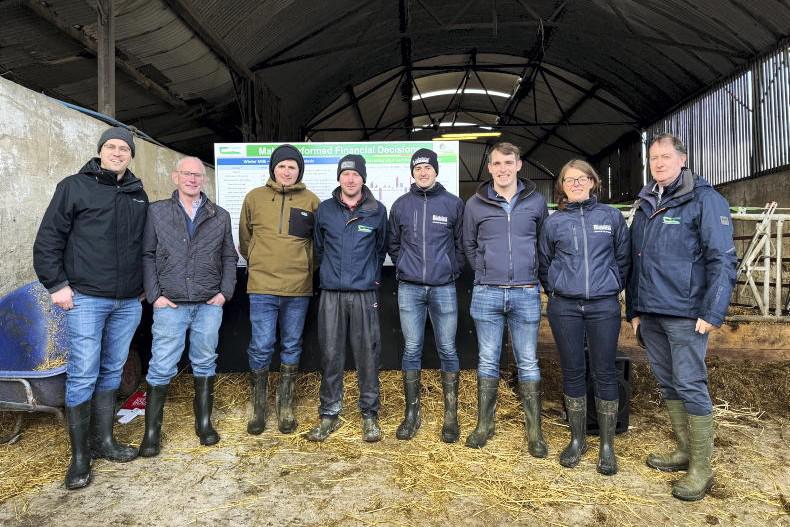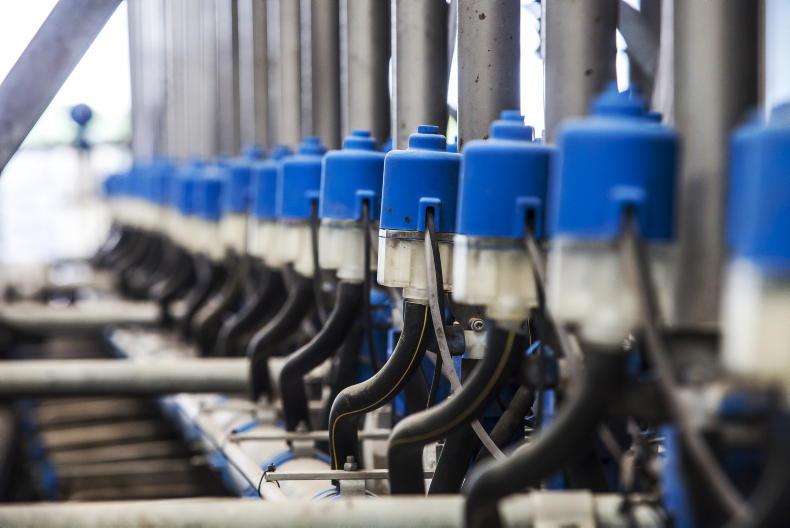The number of specialist liquid milk producers in the Republic of Ireland continues to decline.
Over the last two years, over 100 farmers have exited liquid milk and almost 700 have exited over the last 10 years.
The situation is more stable in Northern Ireland with a flatter supply curve and a history of two calving periods ingrained in the system.
While the advantages and disadvantages of producing milk over the winter in Ireland can be debated, everyone acknowledges that it takes hard work and dedication. The following are steps that can be taken to reduce the workload.
Farmers who don’t have set milking times tend to work until later in the day as pre-milking tasks inevitably drag on.
A 16:8-hour milking interval works well and is recommended by Teagasc for spring-calving herds.
This means there is an eight-hour interval between milkings, meaning cups can go on at 7am and again at 3pm.
However, many farmers, particularly with higher-yielding herds, go for longer intervals of 10- or even 12-hour intervals meaning the working day is much longer.
While there may be slight benefits in terms of milk yield (1% to 2% more milk according to some studies with high-yielding cows) with longer intervals, it has to be weighed up against the workload factors and the long working day.
Simplify the
feeding system
There is very often a mismatch between animal nutrition and milk production on winter milk farms.
More often than not, farmers are going to enormous effort and cost to provide a high-quality diet and are often disappointed with the resultant milk yield.
There are a lot of people making a living out of winter milk and not just the farmer. Between nutritionists, feed mills, additive suppliers, machinery and diagnostics, it’s a big business.
Adapting US style-feed systems to Irish farms doesn’t always pay off. I know that some of the most profitable winter milk producers don’t have diet feeders or elaborate diets. They feed out blocks of good-quality silage and/or maize and buy a high-quality dairy nut fed through in-parlour feeders.
A disease breakdown is not only costly but hugely draining on energy and morale. Maintaining good animal health status is more difficult in split-calving herds as there are multiple groups of different aged animals, often sharing the same air-space. Plus, facilities such as calf sheds and calving pens are in more regular use, which increases the risk of infection transferring from animal to animal.
A herd health plan is essential. The best plans are written into a large year planner on the wall, with the timings of doses or vaccines inserted into the planner for each stock category.
A huge amount of time can be taken up rearing calves. There is no correlation between the time rearing calves and calf health or calf thrive.
A couple of points: moving calves to group pens early in life reduces workload dramatically compared to individual pens.
Desired amount of colostrum
Stomach-tubing calves is much quicker than nipple feeding and there is certainty that the calf has received the desired amount of colostrum.
Calves can be successfully trained on to computerised calf feeders at four or five days of age.
Prepare for the unexpected
Severe weather events such as storms, snow or severe frost are more likely during the winter months and these issues often pose a big threat to winter milk producers.
Have a checklist of items and go through it accordingly. For example, run the generator once every two months for a few hours to make sure that it is working correctly.
Always have sufficient concentrate feeds to last three or four days, so there will be supply in the event of delivery issues.
Have backup space heaters at the ready in the event of severe frost to keep milking parlours and plant rooms from freezing over.
Keep tractors, implements and automatic scrapers serviced and carry a stock of spare parts.
There are additional workload challenges for specialist winter or liquid milk producers over and above spring-calving farms but steps can be taken to reduce the workload. Implementing a shorter interval between milkings will have small impact on milk yield but can greatly reduce the length of the working day. Stomach-tubing newborn calves and rearing young calves in groups is an effective way of reducing workload without affecting calf health. Prepare for severe weather events over the winter and take action to reduce the impact.
The number of specialist liquid milk producers in the Republic of Ireland continues to decline.
Over the last two years, over 100 farmers have exited liquid milk and almost 700 have exited over the last 10 years.
The situation is more stable in Northern Ireland with a flatter supply curve and a history of two calving periods ingrained in the system.
While the advantages and disadvantages of producing milk over the winter in Ireland can be debated, everyone acknowledges that it takes hard work and dedication. The following are steps that can be taken to reduce the workload.
Farmers who don’t have set milking times tend to work until later in the day as pre-milking tasks inevitably drag on.
A 16:8-hour milking interval works well and is recommended by Teagasc for spring-calving herds.
This means there is an eight-hour interval between milkings, meaning cups can go on at 7am and again at 3pm.
However, many farmers, particularly with higher-yielding herds, go for longer intervals of 10- or even 12-hour intervals meaning the working day is much longer.
While there may be slight benefits in terms of milk yield (1% to 2% more milk according to some studies with high-yielding cows) with longer intervals, it has to be weighed up against the workload factors and the long working day.
Simplify the
feeding system
There is very often a mismatch between animal nutrition and milk production on winter milk farms.
More often than not, farmers are going to enormous effort and cost to provide a high-quality diet and are often disappointed with the resultant milk yield.
There are a lot of people making a living out of winter milk and not just the farmer. Between nutritionists, feed mills, additive suppliers, machinery and diagnostics, it’s a big business.
Adapting US style-feed systems to Irish farms doesn’t always pay off. I know that some of the most profitable winter milk producers don’t have diet feeders or elaborate diets. They feed out blocks of good-quality silage and/or maize and buy a high-quality dairy nut fed through in-parlour feeders.
A disease breakdown is not only costly but hugely draining on energy and morale. Maintaining good animal health status is more difficult in split-calving herds as there are multiple groups of different aged animals, often sharing the same air-space. Plus, facilities such as calf sheds and calving pens are in more regular use, which increases the risk of infection transferring from animal to animal.
A herd health plan is essential. The best plans are written into a large year planner on the wall, with the timings of doses or vaccines inserted into the planner for each stock category.
A huge amount of time can be taken up rearing calves. There is no correlation between the time rearing calves and calf health or calf thrive.
A couple of points: moving calves to group pens early in life reduces workload dramatically compared to individual pens.
Desired amount of colostrum
Stomach-tubing calves is much quicker than nipple feeding and there is certainty that the calf has received the desired amount of colostrum.
Calves can be successfully trained on to computerised calf feeders at four or five days of age.
Prepare for the unexpected
Severe weather events such as storms, snow or severe frost are more likely during the winter months and these issues often pose a big threat to winter milk producers.
Have a checklist of items and go through it accordingly. For example, run the generator once every two months for a few hours to make sure that it is working correctly.
Always have sufficient concentrate feeds to last three or four days, so there will be supply in the event of delivery issues.
Have backup space heaters at the ready in the event of severe frost to keep milking parlours and plant rooms from freezing over.
Keep tractors, implements and automatic scrapers serviced and carry a stock of spare parts.
There are additional workload challenges for specialist winter or liquid milk producers over and above spring-calving farms but steps can be taken to reduce the workload. Implementing a shorter interval between milkings will have small impact on milk yield but can greatly reduce the length of the working day. Stomach-tubing newborn calves and rearing young calves in groups is an effective way of reducing workload without affecting calf health. Prepare for severe weather events over the winter and take action to reduce the impact. 








SHARING OPTIONS